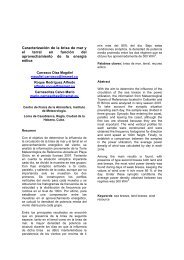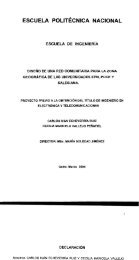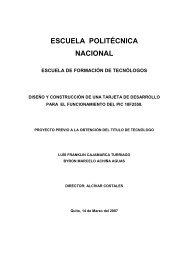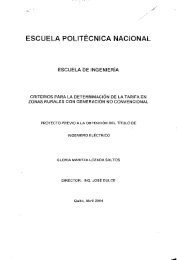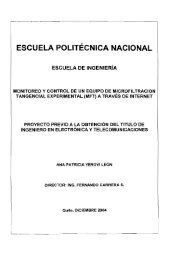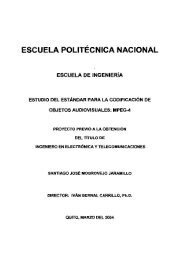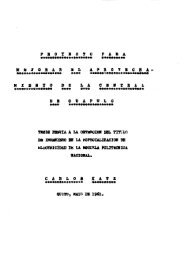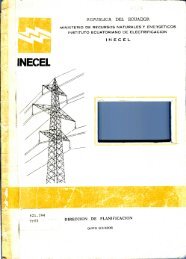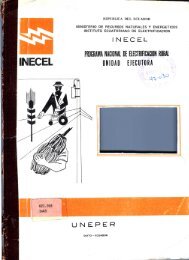Tesis previa a la obtención del Título de Ingeniero en Electrónica y ...
Tesis previa a la obtención del Título de Ingeniero en Electrónica y ...
Tesis previa a la obtención del Título de Ingeniero en Electrónica y ...
You also want an ePaper? Increase the reach of your titles
YUMPU automatically turns print PDFs into web optimized ePapers that Google loves.
'.1 Múltiple B-connections<br />
S and BAS are transmitted in each B-channel (see Note).<br />
NOTE - The actual bit rates allowed by this Recoram<strong>en</strong>dation for these audio codíngs within a 64 kbít/s I-channel are 64<br />
156 Icbit/s, coramands (000) [4/5 and 18/19], respectively. Thus in a 2B audiovisual cali ít !s not permitted to transrait fraraed G.711<br />
lio in the I-channel and vi<strong>de</strong>o ín the additíonal channel. The two. channels raust be synchronüsed, the audio raust be set to 56 kbit/s,<br />
I wh<strong>en</strong> the vi<strong>de</strong>o is ON it musí occupy the reraaining 68.8 kbit/s.<br />
S operatíon is as follows:<br />
- multiframe numbering ís used to <strong>de</strong>termine re<strong>la</strong>tíve transmission <strong>de</strong><strong>la</strong>y betwe<strong>en</strong> B-channels as <strong>de</strong>scríbed in<br />
2.2;<br />
- the channel numbers are transmitted as <strong>de</strong>scribed in 2.2 with the channel of the initial connection being<br />
numbered 1 and there being up to five additional connections;<br />
- the outgoing A-bit is set to 1 Ín the additional B-channel of the same connecüon wh<strong>en</strong>ever the received<br />
additional channel is not synchronízed to the initial channel;<br />
- wh<strong>en</strong> receive synchronlzation is achíeved betwe<strong>en</strong> the initial and additional channels by introducing <strong>de</strong><strong>la</strong>y<br />
to align their respective multiframe signáis, the transmitted A-bit is set to 0;<br />
- the E-bit for each additional B-channel is transmitted in the additional B-channel in the same connection,<br />
because Ít re<strong>la</strong>tes to a physical condition of the transmission path.<br />
; BAS operatíon in additional connections is restricted to the transmission of the additional channel number and TTX<br />
e Recomm<strong>en</strong>datíon H.230) (thus the channel numbering of any additional connection must be s<strong>en</strong>t both in BAS<br />
ording to Annex A and in the FAS as in 2.2), while channel numbering of the initial channel is s<strong>en</strong>t only in FAS.<br />
i dístant terminal, upon receíving the A-bÍt set to zero with respect to sequ<strong>en</strong>tially numbered channels, can add their<br />
•acity to the initial connection by s<strong>en</strong>ding the transfer rate BAS in Annex A. The or<strong>de</strong>r of the bits transmílted in the<br />
.nnels is in accordance wilh the examples giv<strong>en</strong> in Figure 5.<br />
.2 Múltiple H0 connections<br />
S and BAS are transmitted Ín the fírst time-slot of each HQ-<br />
S operation is as in 2.7.1 except that the channel number is used to or<strong>de</strong>r the six octets received each 125 microonds<br />
with respect to the six octet groups received Ín other channels.<br />
¡ BAS operation in additional channels is as specified in 2.7.1.<br />
Bit-rate allocation signal<br />
Encoding of the BAS<br />
: bit-rate allocation signal (BAS) occupies bits 9-16 of the service channel in every frame. An eight bit BAS co<strong>de</strong> (b0,<br />
b2, b3l 64, b5, bg, b7) Ís complem<strong>en</strong>ted by eíght error correctíon bits (p0, p¡, P2- P3- P-4- P5< P6- P?) to ¡mplem<strong>en</strong>t a (16,8)<br />
ble error correcting co<strong>de</strong>. This error correcting co<strong>de</strong> is obtained by short<strong>en</strong>ing ine (17,9) cyclic co<strong>de</strong> wlth g<strong>en</strong>erator<br />
("normal:<br />
g(x) = x8 + xl + x6 -f x4 + x2 + x + 1<br />
The error correction bits are calcu<strong>la</strong>led as coefficí<strong>en</strong>ts of the remain<strong>de</strong>r polynomíal in the following equation:<br />
PQX1 "f píX6 = p2X5 + /73X4 + p4X3 + pSX2 + p6X + p1<br />
re RESg(x-)[f(x)'] repres<strong>en</strong>ts the residue obtained by dividing/(x) by g(x).<br />
BAS co<strong>de</strong> Ís s<strong>en</strong>t in the ev<strong>en</strong>-numbered frame, whíle ihe assoc<strong>la</strong>ted error correction bits are s<strong>en</strong>t Ín the subsequ<strong>en</strong>t<br />
•numbered frame. The bits of the BAS co<strong>de</strong> or the error correction are transmitted Ín the or<strong>de</strong>r shown in Table 2 lo<br />
¡d emu<strong>la</strong>tion of the frame alígnm<strong>en</strong>t word.<br />
Recomm<strong>en</strong>dation H.221 (03/93) 9



